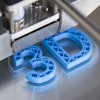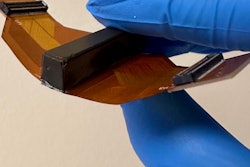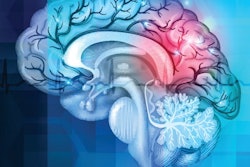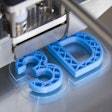A wearable ultrasound sticker the size of a postage stamp can continuously measure tissue stiffness and may have a place in monitoring organ transplantation patients, according to research published February 9 in Science Advances.
A team of researchers led by Hsiao-Chuan Liu, PhD, and doctoral students Yushun Zeng and Chen Gong of the University of Southern California found that their bio-adhesive ultrasound elastography (BAUS-E) sticker can continuously monitor the stiffness of organs over 48 hours and detect subtle changes that could signal the progression of disease such as organ failure and rejection. The group developed the sticker at the Massachusetts Institute of Technology, where Liu was a visiting scientist at the time of the study.
“Our continuous BAUS-E measurements exhibited a similar trend between the increase in liver stiffness and the progression of acute liver failure,” the study authors wrote.
While tissues and organs stiffen as people age, this stiffening is more noticeable in tissues with certain diseases, including cancer. Elastography is an ultrasound method used to measure tissue stiffness and has been shown to detect certain cancers. It is also used to monitor patients who recently underwent organ transplantation, with organ stiffening pointing toward acute failure or rejection.
However, with traditional ultrasound, monitoring cannot be performed continuously. The researchers noted that this means clinicians may miss key moments in which a transplanted organ is failing.
With this method in mind, Liu, Zeng, Gong, et al developed their ultrasound sticker to be worn on the skin and provide continuous imaging feedback on the condition of tissues and organs. However, they also designed the sticker to have the same sensitivity as conventional ultrasound probes.
The authors wrote that they used advanced fabrication techniques to cut small transducers from high-quality piezoelectric materials, making way for their sticker to be postage stamp-sized. They incorporated 128 miniature transducers that were fabricated onto a 25-mm-square chip. From there, the group lined the chip’s underside with a hydrogel-based adhesive. This made room for sound waves to travel in and out of the device.
The researchers performed their preliminary research on rodent models. They reported that the stickers could continuously measure liver stiffness over the course of 48 hours. They also highlighted that the imaging data collected reported “clear and early” signs of acute liver failure, which were confirmed with tissue sampling.
When it came to peak-peak sensitivity, BAUS-E achieved a sensitivity of -4.14 dB while a commercial transducer had a sensitivity of -3.17. A value closer to 0 dB indicates higher sensitivity of the ultrasonic device.
For BAUS-E in B-mode imaging, the lateral resolution and the axial resolution, determined by a -6-dB full-width half-maximum beam profile, were approximately 0.13 mm and 0.36 mm using tungsten wire phantom, respectively. This included target tissues at 13 mm.
“Theoretical calculations predicted lateral and axial resolutions of 0.14 and 0.39 mm, respectively, based on BAUS-E’s center frequency of 7.5 MHz and aperture size of 24 mm,” the researchers added.
The authors indicated that they are working with clinicians to adapt the sticker for use in patients recovering from organ transplants in the intensive care unit (ICU). They added that the sticker is planned to be designed into a more portable, self-enclosed version that patients can wear at home.
“BAUS-E holds great potential for expanding substantial applications of ultrasound wearable devices such as in patients undergoing organ transplantation in ICU, cancer research, and acute decompensated heart failure in clinical settings, in which the benefit of affixing an ultrasound device becomes especially evident,” the team wrote.
The full study can be found here.



















